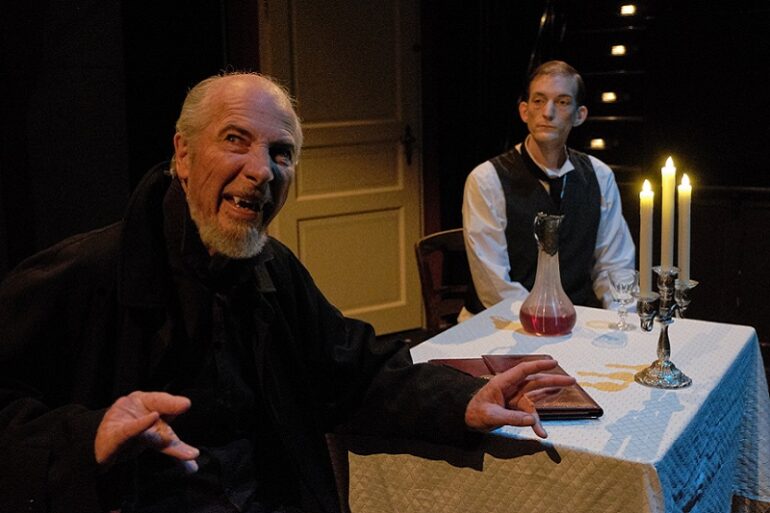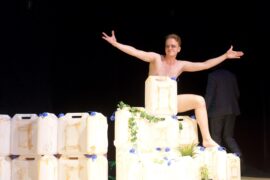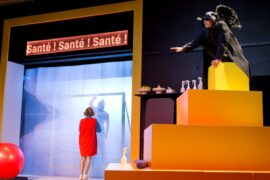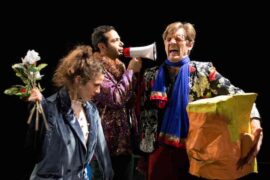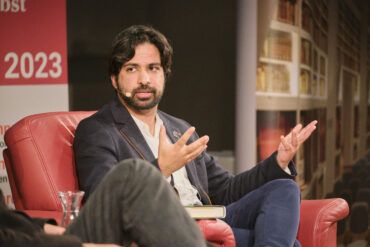The EDW’s interpretation of Dracula encourages the audience to reexamine their perception of gender roles in a male-dominated society. Several spectacular leading actresses magnify this aspect with chilling performances that will send shivers down your spine.
By Anoosh Adell Fouladi
Picture: Dirk Opitz (ThOP)
Dracula is the Gothic horror novel by Irish author Bram Stoker, which firstly introduced the character Count Dracula and is generally viewed as the origin of vampire fantasy in the literary world. Director Richard Varela revives the old legend to be adapted for the stage in this year’s production of the English Drama Workshop Göttingen – performing their annual guest appearance at the ThOP. The audience is treated to an original score with Dracula’s song to open the first act. The music is composed by Alex Sulzberger, while the lyrics were written by Lucas Kade, who also acts as the younger version of Dracula in the play. It is performed by Dracula’s three brides, Valeria (Antonia Krämer), Rodia (Dominique Schlaak), and Aurelia (Olivia Haese). In the darkness, they writhe their bodies in a rhythmic, interpretative dance. Their eerie-pitched singing is creepily delightful. The sorrowful wailing in this opening scene establishes a haunting brooding that sets the tone for the rest of the play. Throughout each act, these three actresses deliver what many fans of gothic horror came here to see: a dark feeling of uneasiness and anxiety.
We are introduced to Vlad the Impaler (Jürgen Bittrich), an aged version of Count Dracula who looks somewhat like Nosferatu – apart from the fact that he appears to be more humanlike than demonic. He plans on purchasing real estate in England from Jonathan Harker (Henning Bakker) and in the process of doing business, imprisons Harker in his castle. Bittrich evokes an enigmatic representation of Dracula. In this scene, the audience sees Dracula as a generous and welcoming host. He is soft-spoken and his body appears frail and elderly, which – as we learn – is due to the fact that he hasn’t consumed blood for centuries. When Bittrich’s character finally feeds on blood, he undergoes a metamorphosis resulting in Bittrich departing and being replaced by Kade, a younger version of Dracula. This dramatic transformation utilizes stage illusion to its best potential.
Most of the other special effects in the play are left to the audience’s imagination. You can only hear growling when Dracula introduces the creatures of the night, so we don’t see any horrific monsters, werewolves, for example, which we tend to associate with the horror genre. Also, the audience has to envision magical displays of power through grandiose hand gestures. Generally, violent scenes, such as the impaling, are somewhat hidden behind props. Nonetheless, the special effects and stage design of Dracula’s transformation display an amazing effort. Bittrich and Kade cleverly switch places by face swapping, using a synthetic skin mask. After the transformation, the younger Dracula appears more dominating and powerful compared to his previous form. Kade’s booming voice and strong stage presence commands the audience to keep their eyes glued to him – wherever he goes. He controls his three undead brides with stronger authority than Bittrich who often communicated with them gently. With his strength rejuvenated by blood, Dracula moves from Transylvania to England. The tale then shifts and focuses around new women characters afflicted by the presence of this younger version of Dracula and his everlasting bloodlust.
The Path to Greatness Does Not Come Without Mistakes
While the play’s dramatic tension is palpable and thoroughly exciting from start to finish, there are areas that need improvement. On several occasions, many of the cast flub their lines. They are quick to correct themselves, but it gets more noticeable each time it occurs. Often, it seems like the transition of stage design is a bit too slow. This affects the lighting team, who sometimes mistime their spotlight. Some of the sound effects feel forced, like the howling of the wolves, or there are delays, like the prop gun firing out of sync with the actor’s arm recoiling. There is a scene where one of the actors tries his best impression of American slang, but it doesn’t sound coherent. It feels contrived and generates a few awkward laughs in the audience. Amongst the male characters, only Bakker’s English accent is believable. Amusingly, Bakker has a minor issue with a curtain that repeatedly prevents his character from closing the door to his room. It becomes so distracting that Bakker improvises a line during his dialogue with Count Dracula. Breaking the fourth wall, he proclaims to the viewers that the curtain is a hindrance and fixes it in the middle of the play to much applause and laughter from the audience. No one expects perfection in any live performance; it comes with the trade of the theatre. Someone in the audience forgets to silence their phone, lightbulbs on the prop candles go out – minor miscues are bound to happen. The devil is in the details. However, Varela’s adaptation of Dracula is a great show because it takes a bold risk in its writing.
In the past several decades, there has been a plethora of new criticism of Stoker by various scholars who perceive Dracula to be an archaic religious response to the New Woman archetype – a feminist ideal born in the late nineteenth century. Writer Henry James helped popularize the term to represent females as heroines in his novels that exercise their intellectual and sexual autonomy. The New Woman challenged the limits of a male-dominated society wherever women were oppressed by misogynistic attitudes toward personal, social, or economic matters. While this play tries to stay true to most of the source material, it seems to veer away in the opposite direction of Stoker. In the novel, men are the driving force that pushes the narrative. With the help of the Christian cross, the heroes of the story are presented to be Johnathan Harker (Henning Bakker), Professor Van Helsing (Johannes Uhlig), Arthur Holmwood (Jooris Preiser), Dr John Seward (Vinzenz Hennings), and Quincey Morris (Mark Tsiolis). However, in Varela’s adaptation, the story takes a different path and embraces the power of women such as Mina Murray (Laura Apel), Lucy Westenra (Daniella Wood), and R. M. Renfield (Karin Reilly).
The Evolution of Mina Murray
Count Dracula isn’t the only person to undergo a transformation in the play. When Mina first introduces herself on stage, she begins as a woman emotionally distraught from being separated from her husband, Harker, who is still trapped in Transylvania. Yet, she puts on a brave face and clearly defines her role as a strong woman determined to become a journalist. She supports her friend Lucy in her time of need. It is Mina who cares about Lucy’s sleepwalking problem and discovers its unnatural cause. After Mina seeks medical help from Dr John Seward to save her friend, she gathers notes from letters she shared with Harker and collects information she could use to confirm the existence of Dracula. Compared to Mina, we witness the role of Lucy to be the stereotypical trope of the beautiful woman who only wants to find love. Dr John Seward and Professor Van Helsing assume Mina’s responsibilities as caretaker and send Mina away. Quincey and Arthur also arrive to provide further protection to Lucy. Wood portrays Lucy as the typical Damsel in Distress, which can be interpreted as emblematic of the depiction of affluent women of the late 19th century. Still, her character manages to pull on the viewer’s heartstrings as she falls victim to Dracula, despite all the efforts the men make in defending her. While the men are united in Lucy’s death, they are unable to comprehend the cause to be Dracula. Only thanks to Mina’s collection of data, Professor Van Helsing is able to discover the means to free the possessed soul from Lucy’s undead body. Professor Van Helsing also manages to find Dracula’s location because of her notes. When Harker returns from captivity, he is mentally unstable but finds solace in Mina’s voice as she consoles him and helps him slowly return to sanity. When the male characters rally to fight Dracula, they cast aside Mina’s aid again in some ill attempt of machoism. They ask her to leave because they feel that they are protecting her from danger. This decision leaves Mina vulnerable to the vampire who aims his next attack at her.
EDW
The English Drama Workshop Göttingen (EDW) has been staging plays for more than 40 years. They are an amateur company open to everyone from in- and outside the university, who is interested in playing in or helping with the production of an English-speaking drama. Currently based under the patronage of the »Zentrum zum Erwerb von Sprachen und Schlüssequalifikationen ZESS«, they put one play a year on the stage of the Theater im OP, usually in spring.
The EDW is Northern Germany’s longest playing regularly English-speaking theatre company.
According to R.M. Renfield, a woman trapped in a psychiatry ward, »Blood is life.« In the original text of Dracula, Renfield is written as a male character. Varela makes an interesting decision to alter this character’s gender since it further establishes the New Woman archetype. Reilly doesn’t disappoint as her character continually injects a dose of creepiness with her dark nursery rhymes alluding her connection with Dracula. Her character is aware of his presence, and often refers to him as »Master.« She is imprisoned for her strange behaviour that includes eating bugs and live animals in their entirety. While it seems as if her character is there to further the plot, Reilly’s eccentric performance is beyond captivating and worth mentioning. By repeating the line »Blood is life,« she reminds the audience to reflect on how blood reanimated her master, rejuvenating his youth and power. Blood is his source of life and magic. His blood can control the minds of others. Her shared thirst for blood is her desire to be equal in power to him. However, her ambition results in her being locked up in a cage. Reilly’s character appears willing to be converted into one of Dracula’s undead wives, but he shows no interest in a woman who is consensual to his urges. After making her personal feelings known to him, she is rejected and physically assaulted by him. Sacrificing her own wellbeing by refusing medical aid, she manages to survive long enough to warn the men – revealing his plan to harm Mina and that she can be saved before being fully drained.
Dracula schemes a plan of controlling Mina by making her drink his blood. He then chants to Mina, referring to her as »Blood of my blood, flesh of my flesh, kin of kin.« Before he can complete his enchantment, the men arrive, forcing him to retreat. Since he did not finish his absolute corruption of Mina, we are to assume that she is in a semi-state of magical hypnotism. You can see Apel’s face is covered in blood, and she delivers a breath-taking performance portraying the trauma she received from Dracula’s attack. Mina’s stunned appearance convinces viewers of her emotional distress, which many viewers can empathize with. Each line she utters invests the audience to sympathize with her state of mind. Professor Van Helsing tries to apply holy water to heal Mina from Dracula’s curse, but it only burns her and seems ineffective. The male characters appear despaired in the face of failure, fearing that after Lucy, they were about to lose another woman they loved.
Parallel to Lucy’s fate, Mina decides she cannot undergo that same ordeal of being saved by men. She will not let the men exclude her again when confronting Dracula in the final battle. In the novel, Harker and Quincey kill the vampire. On the stage of the English Drama Workshop however, none of the men are able to overcome his magical powers. When he is weakened, he tries to summon Mina to complete his dominion over her. In an unexpected twist, Mina breaks free from his curse to deliver the final blow by impaling Dracula to death. The superb writing in the evolution of her character finally reveals her to be the true hero of the story. Mina does not allow herself to become another woman who needs men to save her. If blood is life, then her indomitable will is the soul. Varela does a wonderful job by infusing the New Woman archetype in order to provide a fresh perspective to an old tale. The English Drama Workshop Göttingen brings Dracula alive for all audiences to feast upon and enjoy.


